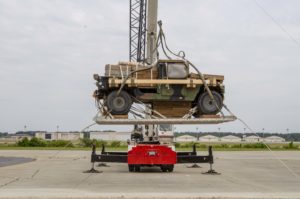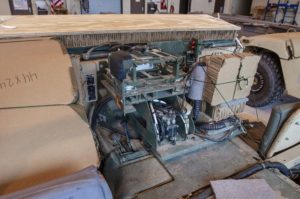By Mr. Blake Bagby, Military Test Plans Analyst, Airborne and Special Operations Test Directorate, U.S. Army Operational Test Command
FORT BRAGG, North Carolina – Paratroopers here are busy developing new procedures to allow the Joint Battle Command-Platform (JBC-P) system to remain installed in HMMWVs during low velocity airdrops (LVAD).
“The fact that I no longer have to remove and then re-install the JBC-P system on the drop zone at 3 a.m. after an Airborne insertion will greatly improve my assembly time and overall situational awareness,” said Pfc. Joseph Cullen, an Airborne Infantryman assigned to the 1st Battalion, 504th Parachute Infantry Regiment.
Troops with 1-504th teamed up with the Airborne and Special Operations Test Directorate and its riggers to work with the JBC-P Program Office, Combat Capabilities Development Center – Soldiers Center (CCDC-SC), at the Fort Lee, Virginia Quartermaster School to achieve the long sought-after enhancement.
“The preparation of the JBC-P system was really quite easy and the fact that the system no longer needs to be removed prior to Airborne operations is a time saver,” said Pfc. Austin Franks, a paratrooper with the 1-504th.
Operational testing took place at Bragg’s Yellow Ramp, late April through early May with Simulated Airdrop Impact Testing (SAIT) and preparation procedure development.
The JBC-P system also underwent a communications exercise following the SAIT where imagery was downloaded, and messages were sent and received. The system performed as designed, with zero errors.
“Leaving the JBC-P system installed in HMMWV’s prior to LVAD operations is a long overdue enhancement for paratroopers overall situational awareness during forced entry operations,” said Mr. Tom Aitken, a JBC-P Program office representative.
Operational testing culminated with the development of preparation procedures to protect the JBC-P system during LVAD and dual row airdrop system operations.
“This addition to rigging procedures means that never again will I find myself looking for the 7/16” bolt that I dropped on the drop zone in a noise and light sensitive environment,” said Spec. Daniel Devore, a Devil Brigade Airborne Infantryman.
~~
About the U.S. Army Operational Test Command:
The U.S. Army Operational Test Command is based at West Fort Hood, Texas, and its mission ensures systems developed are effective in a Soldier’s hands and suitable for the environments in which they train and fight. Test unit Soldiers provide feedback by offering input to improve upon existing and future systems Soldiers will ultimately use to train and fight.
The Fort Bragg, North Carolina-based Airborne the Special Operations Test Directorate (ABNSOTD) plans, executes, and reports on operational tests and field experiments of aerial delivery and air transportation equipment and procedures for airborne and special operations forces to provide key operational data for the continued development of doctrine and fielding of equipment to the Warfighter.



